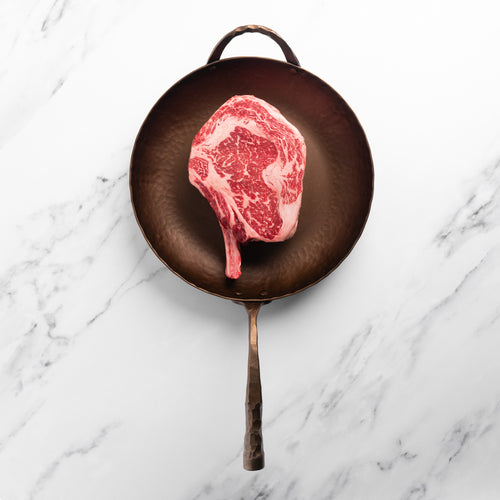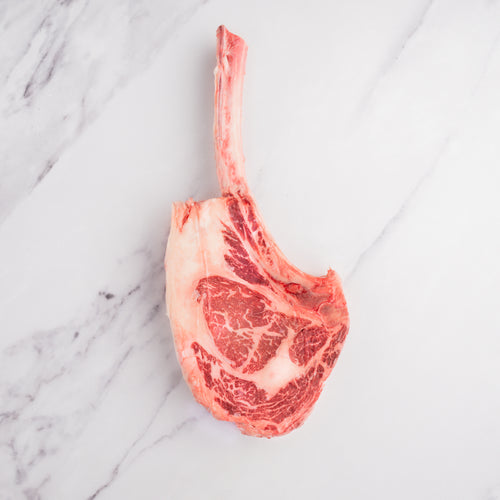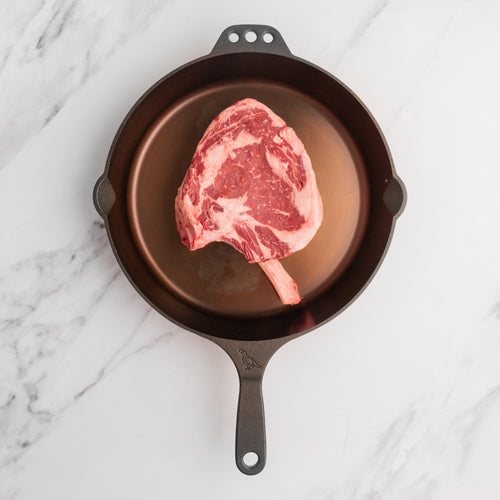
Cowboy Steak vs Tomahawk: What's the Real Difference
The cowboy and tomahawk are two impressive steaks. Deciding which one to bring home doesn’t have to be confusing. Both are thick cut, bone-in ribeye steaks but the primary difference is the length of the rib bone. Either one is a frontrunner to win any steakhouse showdown.
We get questions about these cuts almost every day. What is the real difference? Is it easier to cook the cowboy? Is the Tomahawk’s long bone just for show – or is there more to it?
At Snake River Farms, we have decades of experience cutting and cooking both cowboy and tomahawk steaks. Whether you're deciding what to throw on the grill or what to send as a gift, we’ll walk you through the key differences so you can feel confident choosing the one that fits your moment.
"I have been a long time supporter of SRF. Their product is really unmatched when it comes to the three things I really look for in quality meat; taste, texture and marbling. SRF always hits those markers, creating the perfect balance and bite every time."
- Chef Tim Hollingsworth
|
Table of Contents |

What Is a Cowboy Steak?
The cowboy is a large bone-in ribeye steak that’s cut the full width of a rib bone. The rib bone is frenched, which means the bone is cleaned of any excess material. This gives the cowboy steak a hearty, eye-catching appearance.
This is the steak cowboys are said to have cooked for themselves on the open range. They needed a big steak to fuel them after a long day in the saddle and to get ready for the hard work to come.
What Makes a Cowboy Steak a Cowboy Steak?
This steak is defined by its size and structure. Unlike a boneless ribeye, the cowboy includes a portion of the rib bone, adding weight, visual impact, and flavor during cooking.
SRF Cowboy Steaks are generously cut to the full width of the rib bone, and include two signature muscles: the tender longissimus dorsi (eye of ribeye) and the flavorful spinalis (ribeye cap), separated by rich kernel fat that renders beautifully when seared or grilled.
Want to dive deeper into this bold, bone-in classic? Check out our full Cowboy Steak Guide for expert tips, cooking methods, and why it’s one of our most impressive cuts.
Understanding the Cowboy Steak
-
Frenched bone length: About 2 inches beyond the steak.
-
Steak size: Average weight: 2.5 lbs.
- Contains the fine grained center eye surrounded by the succulent cap.
“This Wagyu cowboy ribeye and the thickness was amazing. Tender, juicy and great taste! I’m a SRF customer for life! I’ve tried other meat companies. SRF has great products, well packaged, and fair price.”
- Vincente G., Verified Buyer
How to Cook a Cowboy Steak for Maximum Flavor
The Cowboy Steak is a large, thick-cut bone-in ribeye with bold flavor and an eye-catching presentation. Averaging 2.5 pounds, it features a signature Frenched bone and the kind of marbling that delivers both richness and tenderness in every bite. Its impressive size and shape make it a natural centerpiece for any special occasion.
To bring out the best in this steak, cook to medium-rare or medium to allow the marbling to fully render. The reverse sear method is ideal—it ensures even doneness throughout and finishes with a beautifully caramelized crust.
Here is step by step guide to reverse sear a cowboy steak using an oven and stove top:
- Season - Heat oven to 250°F to 275°F degrees. Season steak with salt and pepper. Cover a baking sheet with foil and place a metal rack in the middle. The idea is to elevate the steak from the pan.
- Cook - Place the pan and steak in the oven. Bake until the steak reaches your preferred temperature: 120°F for medium-rare, 130°F for medium. This can take 45 to 60 minutes but begin checking the internal temperature at 20 minutes.
- Rest - Remove steak from oven, loosely cover with foil and allow it to rest for 10 to 15 minutes.
-
Sear - Add a light coating of vegetable oil to a heavy skillet and heat over high heat until hot. Sear steak on both sides and the edges for 60 to 90 seconds to form a beautiful crust. Serve.
This method also works outdoors on a gas or charcoal grill. Set up the grill with two cooking zones, a hot side and a cool side. Place all the coals on one side of the grill for the hot side and leave the other side open for the cool side. On a gas grill turn the burner on one side and leave the other burner off.
The steak can be moved to control temperature and avoid charring. Since the cowboy is a richly marbled steak the fat dripping on the coals can cause flare-ups on the hot side. When this happens, move to the cool side.
Ready to try it yourself? Follow our step-by-step Reverse Seared Cowboy Steaks with Chimichurri recipe for a flavorful finish—and don’t forget to stock up on the star of the show. Shop our Cowboy Steaks to bring this impressive cut to your table.

What Is a Tomahawk Steak?
Like the cowboy, the tomahawk is a large bone-in ribeye steak that’s cut the full width of a rib bone. The rib bone is frenched, which means the bone is cleaned of any excess material. The primary difference is the length of the rib bone. It extends about 12 inches beyond the steak which gives the tomahawk a striking, jaw-dropping appearance.
The steak is called a tomahawk because of its resemblance to the Native American tool of the same name. A tomahawk is a single-handed axe that was made with a wooden handle and stone head attached with a leather cord.
What Makes a Tomahawk a Tomahawk?
The tomahawk steak is a thick-cut ribeye steak with the rib bone left in place. This sounds like the description of a cowboy steak, but the tomahawk has a frenched rib bone that is about 10 to 12 inches in length. Although the primary portion of both steaks is almost identical, the long rib bones give the tomahawk a distinctive appearance.
SRF tomahawk steaks are cut the full width of the rib bone which equates to a thickness of about 3-inches. The tomahawk is cut from the rib primal and contains at least 2 different muscles, the longissimus dorsi which is the large center portion and the spinalis or outer section. These two muscles are separated by an unctuous layer of kernel fat.
The entire steak contains an intense amount of rich intramuscular fat (or marbling) which gives the ribeye its hearty beef flavor and juiciness.
Ready to find your perfect tomahawk? Explore our full guide to choosing the ideal cut and shop our premium American Wagyu tomahawk steaks to bring it home.
Understanding the Tomahawk Steak
-
Frenched bone length: about 10 to 12 inches beyond the steak.
-
Steak size: Average weight: 2.5 lbs.
- Contains the fine-grained center eye surrounded by the succulent cap. Flavor and tenderness on par with cowboy, but the long bone puts an emphasis on presentation.
“Finally ordered the Wagyu tomahawk ribeye and was so happy when the box arrived. I salted it once it thawed and dry brined it in the fridge for a few days. Then, the real stuff happened! Placed it in the pellet smoker till it hit my desired temp then used some of the fat off the steak and rendered it so I can sear it in a pan in its own fat for the ultimate crust. Tasted it on its own and tasted it with my compound butter with bone marrow. Excellent steak! Excellent quality and marbling. Thank you Snake River Farms for such an excellent product and such a beautiful cut. I’ll be back for more soon!”
- Bobby, Verified Buyer

How to Cook a Tomahawk Steak Like a Pro
The tomahawk a large steak weighs in about 2 ½ lbs., because it has a high amount of marbling, cooking to medium rare or medium allows the marbling to fully render and produces the best flavor and texture.
- The reverse sear is an excellent method for a cut of this size since it cooks the entire steak consistently. The steak is then seared to create a crisp, flavorful crust.
- You can cook a tomahawk steak outdoors using a charcoal or gas grill. Start the steak at a low temperature of about 250°F to 275°F to evenly cook it from edge to edge, then finish it on a hot grill.
- For a charcoal grill with a lid (like a Big Green Egg or Weber kettle) light a full chimney of charcoal. When fully lit, arrange the coals on one side of the grill and leave the other side open with no coals. Close the lid and adjust the vents so the temperature is 250°F to 275°F. (If using a Big Green Egg, you can also set up indirect cooking with a ceramic convEGGtor.)
- For gas grills, light one burner and leave one off. Close the lid and adjust the burners so the temperature is 250°F to 275°F.
-
Season the tomahawk generously with kosher salt or your favorite steak rub.
- Place steak on the cool side so the indirect heat. Close the lid and cook until the internal temperature of the steak reaches your preferred temperature: 120°F for medium-rare, 130°F for medium. This can take 45 to 60 minutes but begin checking the internal temperature at 15 minutes.
When you check the temperature, inspect the steak to see how it is cooking. Flipping the steak helps maintain a consistent cook.
- When the steak comes to your desired temperature, remove and put on a platter.
- Open all the vents or turn the burners on high. Sear the tomahawk on all sides to achieve a golden brown exterior. Use tongs and sear the thick sides to crisp up the fat cap.
- Let rest for 5 to 10 minutes and serve.
- Indoors start in the oven at 250°F to 275°F to bring the steak to temperature and finish on a hot skillet. See the “How to Cook a Cowboy Steak for Maximum Flavor” section above for a full guide.
Want to see the reverse sear in action? Try our chef-tested tomahawk recipes like the Reverse-Seared Tomahawk with Lemon and Herb Butter or the Coffee Crusted Tomahawk with Charred Scallion Chimichurri to bring out the best in this epic cut.
Cowboy and Tomahawk: Same Cut, Different Style
The cowboy and tomahawk are both large, bone-in ribeye steaks packed with rich marbling, full flavor and tender texture. They both have a fine-grained center eye surrounded by a layer of fat and the luxurious exterior cap. For practical purposes, they are the same cut but in the world of culinary theatrics, the tomahawk is the more photogenic and provides the greatest impact. Here is a side-by-side comparison.
| FEATURE | COWBOY STEAK | TOMAHAWK STEAK |
| CUT TYPE | Thick-cut ribeye | Thick-cut ribeye |
| BONE-IN | Yes | Yes |
| BONE LENGTH | About 2 inches | About 12 inches |
| MARBLING | Intense marbling | Intense marbling |
| FLAVOR | Tender, juicy, bold beef flavor | Tender, juicy, bold beef flavor |
| COOKING METHOD | Reverse sear, grill | Reverse sear, grill |
| COOKING NOTES | Smaller bone length fits 10 or 12" skillet | Long bone requires a flat surface for pan searing |
| PRICE POINT | SRF Gold®: $158 | SRF Gold®: $189 |
| BEST FOR | High-quality casual meals. To elevate a weekend grilling session. Higher end gifting. | Special occasions. Maximum visual appeal. Wow-factor dinners. Gift giving for high impact. |
Which Steak Should You Choose? Our Expert Perspective
Honestly, you can’t go wrong with either of these impressive steaks. Each thick-cut bone-in ribeye is tender, rich and packed with juicy flavor. Any steak lover will jump at the opportunity to dig into these feast-worthy cuts. Here are some factors to consider:
Flavor Comes from the Cut, Not the Bone Length
The length of the bone doesn’t impact the taste; instead, it’s all about how the steak is cooked to ensure the fat melts perfectly throughout the cut.
Both the cowboy and tomahawk steak come from the rib primal, the specific source of high-quality ribeye cuts. This section contains rich marbling that creates tenderness and exceptional beef flavor. Steaks cut to 3 inches are rare and offer a robust dining experience.
Why We Offer Both Cowboy and Tomahawk Steaks
Choosing a steak is based on personal preference and the dining occasion. For the more practical home cook, the additional cost of a tomahawk doesn’t pencil out. The shorter frenched rib bone makes the cowboy steak easier to cook in a standard sized skillet and to fit on smaller grills.
For fans of the tomahawk steak, the chorus of oohs and aahs that fill the air when a tomahawk is placed on the table is a priceless experience. This is the steak that is a show-stopping centerpiece, where the dramatic presentation of a tomahawk takes center stage.
Gifting: Both cuts make amazing gifts. Whether you're celebrating Father's Day or sending a gift box for a special occasion, you can’t go wrong with either steak. A single steak makes a great gift or choose a curated SRF box for a greater impression.
-
Tomahawk Treasures
A gift box with two SRF Gold® tomahawk steaks is one of our most spectacular gifts.
-
The Great Gift
A SRF Gold® cowboy steak is accompanied by SRF Black® ribeyes and 2 SRF Gold® NY strips to create a steakhouse experience in a box.
-
Steak Subscriptions
A Snake River Farms steak subscription lets you send high-quality steaks like these directly to your door, making both cuts available for every type of occasion.
Still deciding between a cowboy steak and a tomahawk? Here are answers to some common questions to help you choose with confidence.
Frequently Asked Questions about Cowboy Steak vs. Tomahawk
Are Cowboy and Tomahawk Steaks the Same Cut?
Which One is Easier to Cook?
Why is it Called a Cowboy Steak?
How to Choose the Right Steak for You
There is no right or wrong when it comes to comparing the cowboy to the tomahawk steak. Both are savory bone-in ribeye steaks, but here are some things to keep in mind:
Think About Your Grill or Oven Size
Key Point: If you have a smaller grill or pan, the tomahawk may be a challenge to fit, so the cowboy steak could be the better choice.
Curious why thickness matters more than weight? Learn how we cut our steaks for ideal cooking results—no matter the cut—in our guide to SRF steak thickness. Read the article.
Choose Based on the Occasion
Cowboy Steak: Best for weekday indulgences or casual get-togethers where you want to elevate the dining experience. Perfect for grilling up a delicious meal with ease.
Tomahawk Steak: Ideal for big occasions—think special dinners, celebrations, or gifting as a showpiece.
Hosting a dinner party? Whether it’s a girls’ night or a guys’ night in, you can easily swap in a cowboy or tomahawk steak to elevate the menu and make your gathering unforgettable.
Still Can’t Decide? Try Both!
Key Point: If you’re still on the fence, consider ordering both cuts for a steak-tasting night or a side-by-side cooking experiment.
Gift Solution: E-gift cards are a perfect option for those who want to let someone choose their steak based on personal preferences.
Whether you lean toward the rugged cowboy or the dramatic tomahawk, both cuts deliver rich flavor and striking presentation. Thanks to the incredible marbling of our American Wagyu, you can’t go wrong either way—just pick the one that fits your occasion.

Author Bio
Dave Yasuda has worked with Snake River Farms for over 12 years, cooking virtually every product we sell. He has prepared SRF products for photoshoots, food festivals, company events, and customers. A skilled home cook, Dave has collaborated in the kitchen with award-winning chefs, recipe developers, and content creators to enhance his culinary skills. He has also been a featured guest on numerous food-centric podcasts, including Bon Appetit’s “Dinner SOS” hosted by Chris Morocco.









